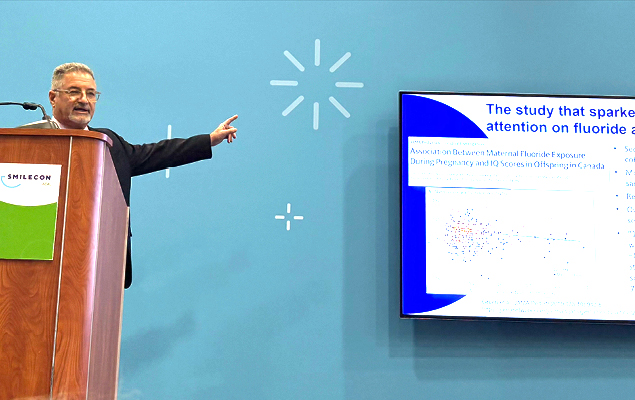Highlighting facts about community water fluoridation
This well-attended session at the ADA Hub Stage in Dental Central at Smilecon 2025 focused on explaining the history of community water fluoridation and exposing the flaws in recent high-profile studies claiming fluoride in public water leads to lower IQ scores in children.

Despite decades of scientific validation and measurable public health success, community water fluoridation continues to face waves of misinformation. During the session The ABCs of Community Water Fluoridation: Science, Specifics, and Stats” at Smilecon 2025, a pair of experts — Liz Lense, D.D.S., senior scientist for population health programs at the ADA, and Scott L. Tomar, D.M.D., Dr.PH, professor and associate dean for prevention and public health sciences at the University of Illinois Chicago College of Dentistry — took a detailed look at the evidence supporting the public health benefits of community water fluoridation, while explaining the misinterpreted data at the heart of recent publications that claim fluoridated water is a threat to public health
“There’s so much misinformation out there,” Dr. Lense began, explaining that fluoride is not a synthetic chemical additive but a naturally occurring element—the 13th most common in the Earth’s crust. Naturally present in oceans at 0.8–1.4 ppm, fluoride levels in groundwater vary widely across the U.S., often higher west of the Mississippi.
The journey toward intentional community water fluoridation began in 1901, when Dr. Frederick McKay moved west and investigated the mysterious “Colorado brown spots” he noticed on children’s teeth. With the help of Dr. G.V. Black, it was discovered that while the teeth were mottled, they were remarkably resistant to decay. Subsequent studies by Dr. Henry Klein and others revealed that higher natural fluoride levels correlated with fewer cavities—and that a concentration around 1 ppm prevented decay without causing discoloration.
When controlled trials began in 1945, cities with fluoridated water saw up to 60% fewer cavities when compared with similar cities that did not add fluoride to the public water supply. Today, the U.S. Public Health Service recommends a concentration of 0.7 mg/L (ppm)—a level that balances preventive benefits with minimal risk, Dr. Lense explained
By age 8, more than half of U.S. children have had a cavity, and by age 18, that number rises to more than two-thirds of the population, Dr. Lense said. Community water fluoridation remains critical because it reaches everyone, especially those with the greatest need a she pointed to studies showing that lower-income populations receive the biggest benefit from community water fluoridation.
“Studies show that you really see a difference in these kids,” she said.
Dr. Lense emphasized that fluoride must be ingested to be absorbed—it cannot be taken in through skin contact—and that its safety and efficacy have been supported by thousands of studies.
Some of the strongest evidence comes from “cessation studies,” where communities that stopped fluoridating their water saw significant increases in decay. Dr. Lense specifically cited studies of the impact following decisions to cease community water fluoridation in Calgary, Ontario, and Juneau, Alaska.
Fluoridated water also provides measurable economic benefits, as treatment costs are lower in cities that maintain fluoridation, she noted, adding that beyond the cost savings, reducing the number of cavities frees up time for dentists to see patients with other oral health care needs.
Dr. Lense closed her segment of the presentation with a recommendation that clinicians and patients can use ADA’s freely available "Fluoridation Facts" as an evidence-based reference for countering misinformation.
Dr. Tomar, who serves on the ADA’s National Fluoridation Advisory Committee, acknowledged that opposition to fluoridation has existed since its inception, but said recent concerns linking fluoride exposure to lower IQ in children stem from methodologically weak studies.
The study most often cited used maternal spot urine samples to estimate fluoride exposure, but fluoride levels in urine fluctuate throughout the day, making that an unreliable measure, he explained. The same study’s data also showed twice the negative impact on IQ attributed to fluoride from the city the children lived in, leading Dr. Tomar to joke that perhaps the take-away should be that children living in Canadian cities other than Vancouver are at risk for lower IQs.
Other methodological issues included inconsistent data collection and the lack of public access to the underlying data. “We should never base clinical or public health decisions on a single study,” Dr. Tomar cautioned.
Dr. Tomar next explained what happened when the results of this Canadian IQ study became the impetus for a review of fluoride’s potential neurodevelopmental effects by the National Toxicology Program. While the NTP set out to collaborate with the National Academies of Sciences, Engineering, and Medicine in this research, the NTP’s draft reports received significant criticism from NASEM for methodological flaws. Rather than addressing these concerns, Dr. Tomar explained that the NTP ultimately bypassed NASEM when it published its final report with a claim that fluoride exposure is connected to negative neurodevelopmental outcomes.
It doesn’t take a deep look at the report to identify concerns with the research, Dr. Tomar explained. Of the 72 studies reviewed by NTP, 53 were considered at high risk for bias, and most were based on populations in areas of India or China with extremely high natural fluoride levels — some above 50 ppm. Studies conducted in Canada, Denmark, New Zealand, and Taiwan, where fluoridation levels more closely mirror those in the U.S., have consistently found no association between community water fluoridation and IQ.
“I would say there is no association between community water fluoridation and changes in IQ,” Dr. Tomar stated, noting that the NTP report and its supporters are causing, “real damage to public health.”
The NTP report has been the basis for a lawsuit against the U.S. Environmental Protection Association where the judge used it as the basis in ruling that community water fluoridation is a threat to the IQ of children. While appeals in that case are pending, Dr. Tomar said it seems clear the judge did not understand the flawed nature of the research in that report.
Both presenters underscored that community water fluoridation remains one of the most effective, equitable, and scientifically supported measures for preventing dental decay. Unfortunately, misinformation continues to circulate and to inform public policy decisions, and thus it remains critical for dental professionals to understand the flaws in the research in order to cite more reliable studies when promoting the public health benefits of community water fluoridation.



